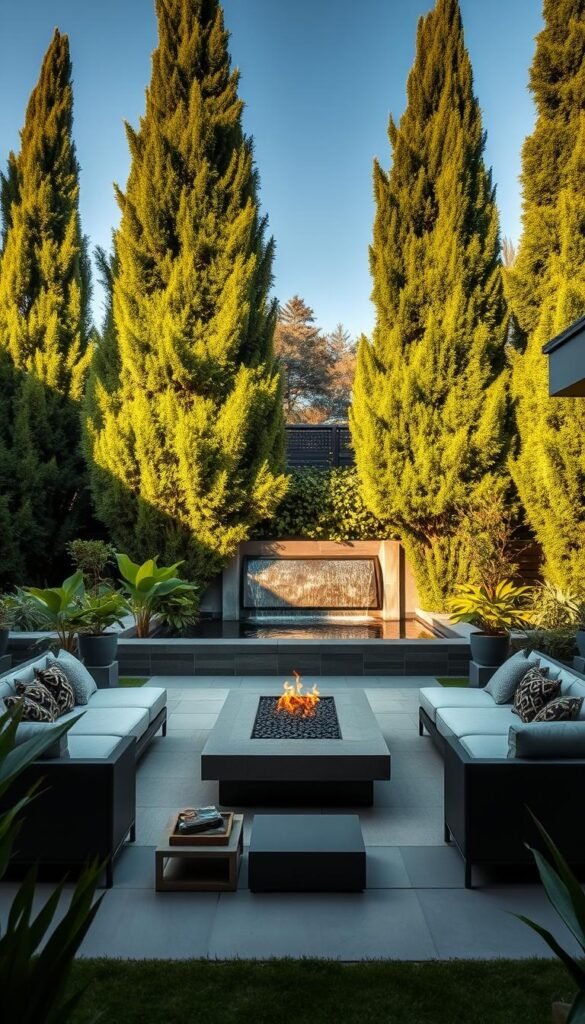Your property’s exterior holds untapped potential to become a personalized sanctuary. With clever planning, even modest areas can evolve into functional extensions of your home that blend style with practicality. Think of your yard as a blank canvas waiting for creative touches that reflect your lifestyle.
Contemporary design thrives on simplicity. Clean shapes, multi-purpose features, and cohesive materials create harmony between indoor comfort and nature-inspired settings. Vertical gardens or tiered planters maximize limited square footage, while weather-resistant furniture ensures durability without sacrificing aesthetics.
Lighting plays a crucial role in setting the mood. Solar-powered path markers or pendant lights above seating zones extend usability into evening hours. Fire pits or compact heaters add warmth, making your retreat enjoyable across seasons.
Whether hosting gatherings or seeking quiet moments, thoughtful layouts make every inch count. Built-in benches double as storage, while modular seating adapts to different occasions. By focusing on flexible elements, you craft zones that grow with your needs.
Through strategic choices in textures, greenery, and layout, your outdoor area becomes more than just grass and pavement. It transforms into a living space where memories unfold naturally.
Understanding Outdoor Living and Garden Design
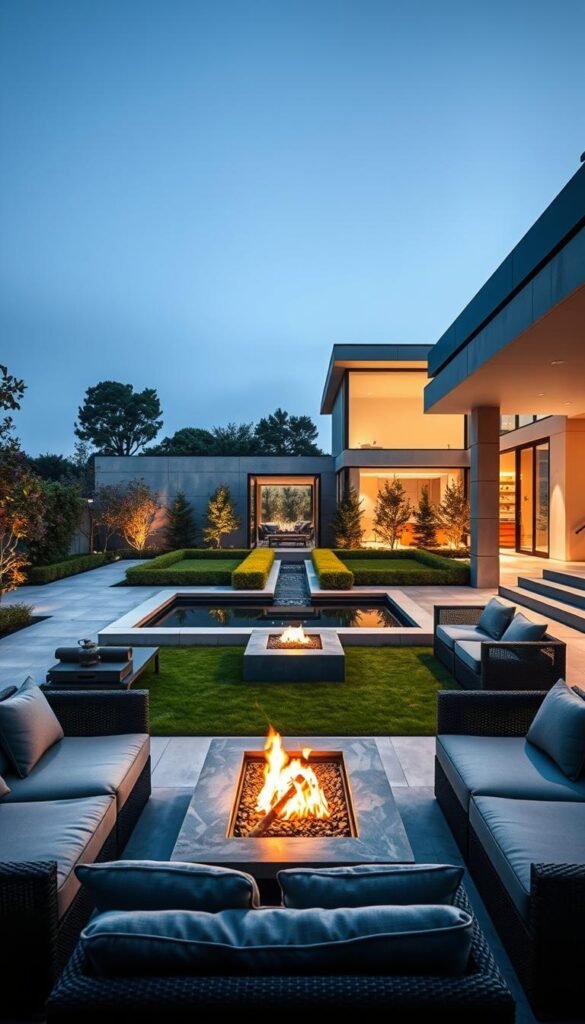
Modern outdoor spaces blend comfort and nature through intentional design choices that mirror your indoor lifestyle. Think beyond basic patios – today’s exteriors become true extensions of your home, merging practicality with visual harmony.
Key Elements of a Modern Outdoor Space
Clean lines and mixed materials define contemporary style. Combine poured concrete with warm wood accents or pair geometric planters with natural stone pathways. Vertical gardens or wall-mounted herb boxes add depth without eating up floor space.
Sustainability matters. Opt for native plants that thrive in your climate and require less water. Durable, low-maintenance materials like composite decking or powder-coated steel ensure your space stays beautiful with minimal effort.
Design Trends to Inspire You
Neutral backdrops create calm foundations. Add vibrancy through seasonal flowers, colorful throw pillows, or artful ceramic pots. Zoning techniques help separate areas – use gravel for dining zones and artificial turf for play spaces.
Professionals recommend blurring indoor-outdoor boundaries. Extend your interior flooring outside or install sliding glass doors that disappear when open. These touches make your landscaping feel like a natural next chapter of your home’s architecture.
Assessing Your Backyard Space and Setting Priorities
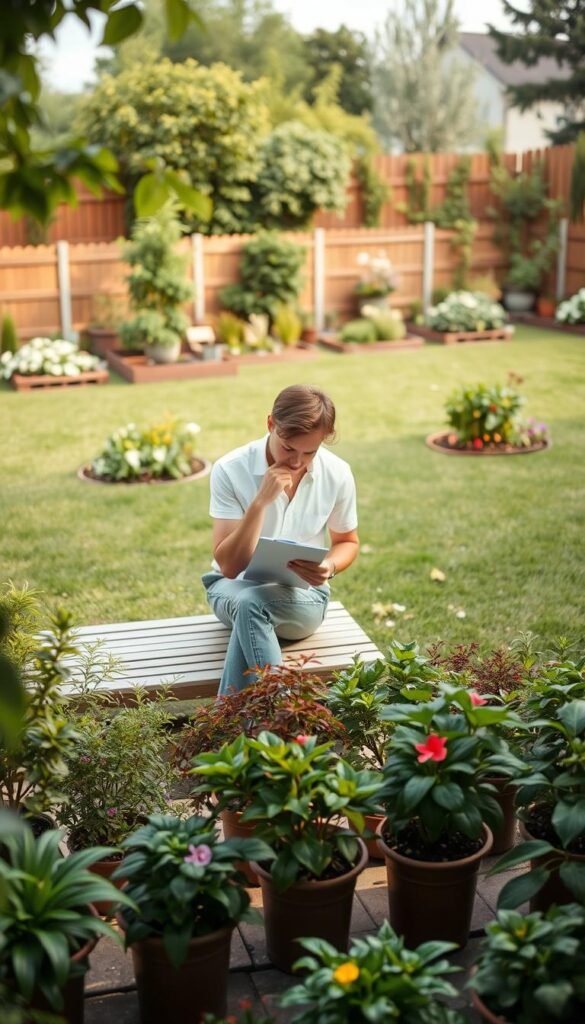
Transforming your yard starts with understanding its potential and limitations. Grab a tape measure and sketchpad first – precise dimensions reveal what’s possible. Note existing trees, slopes, or structures that could influence your layout.
List every dream feature, from fire pits to flower beds. Now rank them: family needs trump wishlist items. A dining zone might outweigh that Instagram-worthy water feature if you host weekly barbecues. Even open lawn space matters – it’s where memories of catch games happen.
| Priority Type | Examples | Considerations |
|---|---|---|
| Must-Have | Seating, dining area | Daily use, family meals |
| Nice-to-Have | Outdoor kitchen, pond | Budget, maintenance |
| Future-Proof | Adjustable lighting, modular planters | Growing kids, changing tastes |
Sunlight patterns dictate plant choices – track shadows throughout the day. Damp spots? That’s your future rain garden location. Soil tests prevent wasted money on incompatible greenery.
Budget smartly: phase projects using square-foot gardening principles. Start with functional zones, add decorative elements later. Remember – foldable furniture works overtime as extra seating or impromptu side tables.
Planning a Functional Layout for Your Outdoor Area
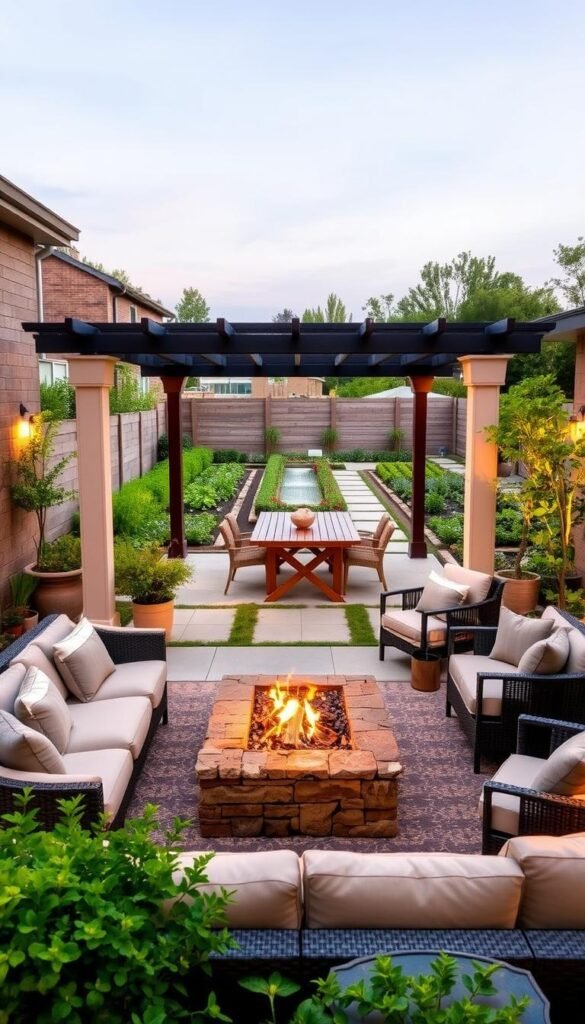
Smart spatial organization turns cramped yards into versatile retreats. Start by sketching how you’ll navigate between key features – like walking from your kitchen door to the grill station without tripping over planter boxes.
Traffic Flow and Zoning Considerations
Map natural walkways first. Keep main paths at least 3 feet wide for easy movement. Curved walkways feel more inviting than straight lines, especially in tight space.
Think about connections:
- How guests reach seating from the house
- Access to storage sheds or tool areas
- Clear routes around fire pits or water features
Use low hedges or decorative screens to guide movement without blocking views. This keeps your design feeling airy while preventing foot traffic through flower beds.
Creating Defined Zones with Outdoor Rugs
Define activity hubs visually instead of building walls. A bold-patterned rug under lounge chairs signals a relaxation zone. Pair it with a matching coffee table to anchor the area.
Try these combos:
- Durable polypropylene mats under dining sets
- Round jute rugs encircling fire pits
- Striped runners leading to hot tubs
Rotate rugs seasonally – lighter tones for summer, deeper hues for fall. This simple switch refreshes your patio without major renovations.
12 Backyard Garden Ideas for Creating Modern Outdoor Living Spaces
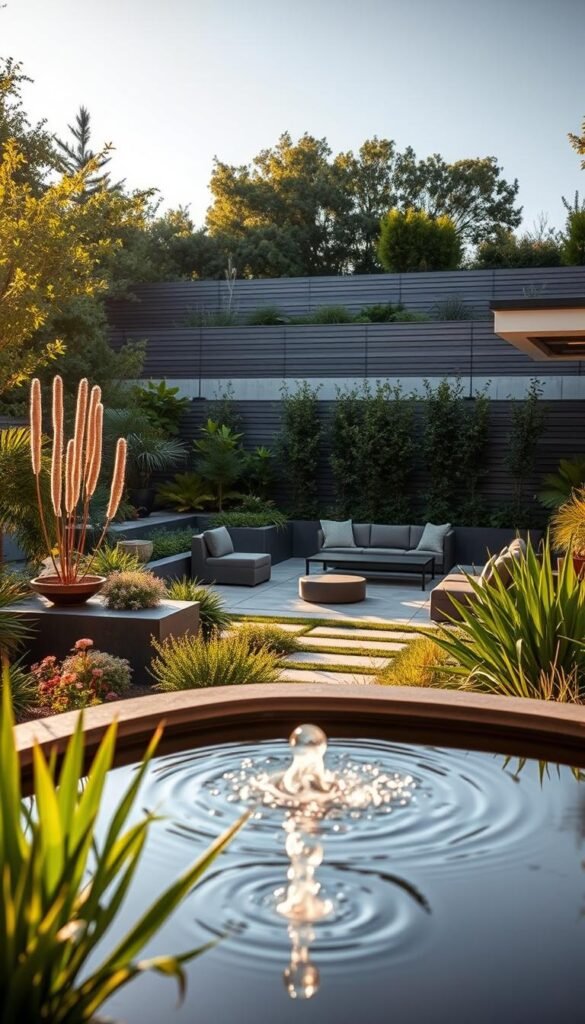
Transform your yard into a stylish retreat with innovative concepts that merge beauty and purpose. From multi-level planters to sleek fire pits, these solutions adapt to various layouts while maintaining contemporary appeal.
Covered structures like pergolas extend usability across seasons, offering shade in summer and shelter during light rains. Pair them with climbing vines or retractable screens for added privacy. Edible gardens double as decor—think rosemary hedges or strawberry towers that save ground space.
Create intimate corners with bistro sets or built-in benches flanking a water feature. String lights or recessed deck lighting add ambiance after sunset, turning ordinary evenings into memorable gatherings. Fire bowls become natural focal points, encouraging year-round use of your sanctuary.
Don’t overlook vertical surfaces. Wall-mounted herb planters or hanging succulents bring life to blank walls without sacrificing square footage. For cohesive styling, repeat materials used in your home’s architecture—like matching stone veneers or metal accents.
Explore modern backyard concepts that balance form and function. Mix these elements to craft a personalized oasis where every detail serves both practical and aesthetic roles.
Maximizing Small or Quirky Backyard Spaces
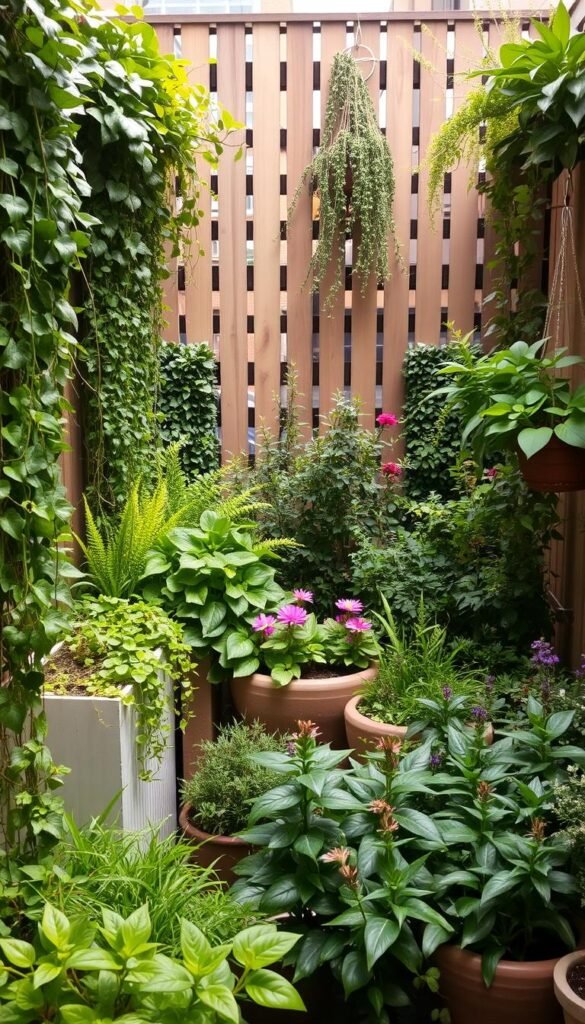
Compact yards challenge you to think creatively about every square foot. Unusual layouts become assets when approached with smart solutions that prioritize both style and efficiency.
Creative Storage and Multi-Use Solutions
Dual-purpose furniture transforms cluttered areas. Consider benches with hidden compartments or nesting tables that shrink when not needed. A coffee table with built-in planters adds greenery while holding drinks.
Hidden storage keeps essentials accessible yet invisible:
- Under-seat bins for cushions
- Hollow faux rocks hiding garden tools
- Wall-mounted racks for space-eating hoses
Repurposed items shine here – try wooden crates as modular shelves or vertical herb gardens. These touches add character while solving practical needs.
Vertical Gardening and Space-Saving Techniques
Turn blank walls into living art with pocket planters or trellis systems. Climbing plants like jasmine create natural privacy screens, while stacked planters let you grow tomatoes and basil in tight quarters.
Maximize overhead areas with:
- Hanging baskets of trailing ivy
- Wall-mounted water features
- Retractable awnings that free up ground space
Mirror tricks work wonders – position one to reflect your best landscaping feature, instantly doubling visual depth. Keep pathways clear with curved gravel trails that guide movement without sharp corners.
Incorporating Hardscape and Softscape Features
Your choice of materials shapes your yard’s personality more than you might think. Strategic combinations turn ordinary surfaces into design statements that work with nature rather than against it.
Modern Patios, Pavers, and Stone Elements
Concrete patios gain character when paired with unexpected textures. Extend yours using pea gravel borders – a budget-friendly trick that adds visual rhythm to flat surfaces. You’ll create depth while keeping maintenance low.
Pavers do double duty as pathfinders and style markers. Lay them in geometric patterns to connect your deck to other zones. This approach guides foot traffic while making your landscaping feel intentional.
Natural stone brings earthy textures to sleek designs. Use slate slabs for retaining walls or tumbled basalt around fire pits. These elements anchor your space to the ground, blending modern lines with organic warmth.
Match materials to your home’s exterior for harmony. If your facade has brick accents, repeat those tones in patio pavers. Test samples at different times – morning light might make gray concrete look blue, while sunset enhances terracotta hues.
Blending Indoor and Outdoor Living Areas
The magic of a truly connected home lies in how effortlessly your indoor comforts meet fresh air and sunlight. French doors aren’t just architectural details – they’re invitations to expand your living areas beyond four walls. When designed thoughtfully, these transitions make your entire property feel cohesive.
Seamless Transitions with Doors and Windows
Oversized glass panels dissolve barriers between rooms and nature. Sliding doors with slim frames maintain sightlines, while energy-efficient windows keep temperatures stable. Match interior and exterior finishes – like bronze handles inside and out – to reinforce continuity.
Strategic planters help too. Place leafy greens near entryways to create natural curtains. This softens edges while maintaining airflow. For more creative gardening ideas, consider wall-mounted herbs that peek through kitchen windows.
Extending Your Living Room Outdoors
Repeat your interior flooring material on patios for visual flow. If you have hardwood floors inside, try composite decking in similar tones outside. Weather-resistant rugs in matching hues tie spaces together.
| Transition Technique | Key Benefit | Example |
|---|---|---|
| Material Continuity | Visual Harmony | Indoor tiles extending to patio |
| Color Coordination | Design Unity | Outdoor cushions matching sofa |
| Furniture Style | Functional Flow | Indoor sectional mirrored outside |
Add ceiling lights above exterior seating that mirror your living room fixtures. This subtle repetition makes both areas feel like parts of one unified space. Before you know it, Sunday coffee migrates naturally from the couch to the patio.
Integrating Pergolas, Gazebos, and Shade Structures
Covered structures redefine how you experience your yard, offering both style and practical solutions. Pergolas stand out as versatile additions, framing areas for dining or relaxation while adding vertical interest. With options ranging from sleek metal frames to rustic wood beams, they adapt to your existing patio aesthetics effortlessly.
Finding the Right Covered Structures for You
Pergolas excel at creating semi-shaded zones without blocking sunlight completely. Train climbing roses or ivy across their beams for natural privacy screens. Explore versatile pergola designs that complement your home’s architecture – horizontal slats suit modern homes, while arched tops enhance cottage-style spaces.
Gazebos provide full coverage for rainy-day enjoyment. Position them near water features or flowering shrubs to create destination points. For smaller yards, opt for cantilevered shade sails that float above seating space without bulky supports.
Consider sightlines when placing structures. A well-positioned pergola can visually connect disconnected garden areas, while maintaining airflow and light penetration. Match roofing materials to your needs – retractable canvas for adjustable shade, or permanent polycarbonate panels for year-round use.

